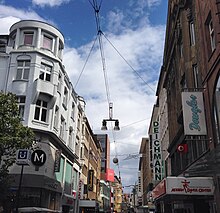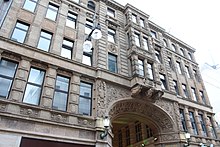Westenhellweg (Dortmund)
| Westenhellweg | |
|---|---|
| Street in Dortmund | |
| The Westenhellweg | |
| Basic data | |
| place | Dortmund |
| District | Downtown |
| Created | 12th Century |
| Connecting roads | Rheinische Strasse (west), Ostenhellweg (east) |
| Cross streets | Kampstrasse , Petergasse, Hansastrasse, Betenstrasse, Petrikirchhof, Lühringhof |
| Subway stations | Kampstrasse, Reinoldikirche |
| use | |
| User groups | shopping street |
| Technical specifications | |
| Street length | 0.9 km |
The Westenhellweg is part of the central shopping street in downtown Dortmund . It is opposite Kampstrasse , which is currently being converted into a promenade.
The Westenhellweg follows the medieval army and trade route Hellweg , which was already used by Charlemagne . Together with Ostenhellweg , it forms the course of the old path within the historical walls of medieval Dortmund. Located in the heart of the city center, Westenhellweg is one of the 10 most popular shopping streets in Germany, according to a study by Jones Lang LaSalle in 2018, with 10,180 visitors per hour at peak times. High rents and full letting of retail space without vacancies indicate the importance of the Westenhellweg as a supraregional shopping street.
history

The name Hellweg is interpreted, among other things, as a “light, broad path”. The Westphalian Hellweg is the most famous Hellweg in North Rhine-Westphalia. It is a more than 5000 year old connection from the Rhine near Alt-Homberg via Duisburg , Essen , Dortmund , Unna , Werl , Soest , Erwitte , Geseke , Salzkotten , Paderborn to Corvey, dating back to pre-Roman-Germanic times . It was part of a via regia from Aachen to Goslar and was already mentioned by Ptolemy .
Within the historical city center of Dortmund, the old Hellweg has been preserved as a shopping street to this day. There the street, which was so important in the Middle Ages, bears the name Osten- und Westenhellweg as an axis between the historic Ostentor and the Westentor. The same street names can also be found in other cities such as Soest , Paderborn and Geseke . In all cases, the designations reflect the geographical orientation of the street from the city centers. While in Dortmund this characterizes the directions from the central point inside the historic city to the Reinoldikirche , in Soest it is the course of the street in front of the gates of the medieval city, the Westenhellweg in front of the old ramparts at the Jakobitor and the Ostenhellweg in front of the Thomätor.
In front of the gates of old Dortmund, the street can easily be followed by its name. Depending on the district, it has appeared since the 14th century as a combination of the place name and the historical path name, in Dorstfeld therefore Dorstfelder Hellweg, mentioned in a document as Dorstfelder Helewege as early as 1345. To the east of the city center, the old Hellweg route is now called Kaiserstraße in the first section, in memory of the magnificent entry of Emperor Charles IV into the imperial city in 1377. In the further course, the connection between Ort and Hellweg is found again , i.e. Körner , Wambeler , named as Hylewege bi Wanemale in 1376 , Brackeler , Asselner and then Wickeder Hellweg, further east, finally beyond today's Dortmund border, Massener Hellweg in the urban area of Unna . The aforementioned Dortmund districts were formerly small, more or less independent places along the street. Korn and Wambel were still on the territory of the county of Dortmund , Brackel and Asseln outside.
Meaning and location
The Westenhellweg begins near the Reinoldikirche , where the Betenstrasse leads to the Alter Markt , and extends as a pedestrian zone about one kilometer to the west. In an easterly direction this extends into Ostenhellweg . At the Petrikirche , the Westenhellweg opens up via the Katharinentreppe to the Dortmund main station .
In the course of the reconstruction after the Second World War , in which the inner city was substantially destroyed, the cross connection Ostenhellweg / Westenhellweg was relieved significantly by the 80 meters north of the crossing Brüderweg - Friedhof - Kampstraße. The Westenhellweg was inaugurated on October 8, 1964 by Mayor Ewald Sprave as Dortmund's first pedestrian zone.
Since Jones Lang LaSalle began measuring pedestrian flows in 1999, Westenhellweg has been one of the busiest shopping streets in Germany, most recently in 6th place ahead of Düsseldorf .
shops
To rent a shop
This high number of visitors has had an impact on shop rents, which are around 250 euros / m² here. Because of the high rents, high-turnover shops, often on a franchise basis, have settled and specialty shops have largely displaced. Well-known fashion chains ( Zara , H&M , New Yorker ), perfumeries ( Douglas ), gastronomy (fast food chains), drug stores ( Müller and dm ) or electronics markets ( Saturn ) are represented in large numbers. In addition to department stores and department stores of various sizes, there are shoe and clothing stores, opticians, sporting goods and multimedia shops as well as bookshops (including the Mayersche bookstore ) and jewelers on Westenhellweg . The usual clothing chains are lined up next to exclusive fashion boutiques or " no-name shops".
gastronomy
Lately there has been an increasing number of restaurants on Westenhellweg, consisting of fast food restaurants such as the Five Guys chain or the frittenwerk.
Outdoor catering
Because of the narrow street width of only ten meters and the constant stream of people in both directions, outdoor restaurants are located on Friedensplatz, Hansaplatz , on the Alter Markt and in the side streets as well as on the church squares of the Petri and Reinoldikirche .
New buildings and openings
Many new buildings and extensive facade redesigns have improved the architectural quality considerably in recent years. The largest construction project in recent years was the construction of the Thier-Galerie with 160 shops on a sales area of over 33,000 square meters (including 5,500 square meters for offices and practices). In the future, other well-known fashion chains such as Sephora will open in Dortmund.
Buildings
The Krügerhaus with the branching off Krügerpassage, the Karstadthaus (former Althoff department store ) and the Petrikirche are located directly on Westenhellweg . The Petrikirche is the only surviving medieval building on this street. The Reinoldikirche is located between Westen- and Ostenhellweg. In the time of the imperial city, there were many municipal institutions on Hellweg, including the Hospital zum Heiligen Geist (Westenhellweg 9, demolition 1911), the new inn (Westenhellweg 108, demolition 1907), the six guild house (Westenhellweg 1, demolition 1846) and the two-building complex existing town wine house (Westenhellweg 3, demolished in 1787).
traffic
The Westenhellweg is a pedestrian zone and vehicles may only be used for delivery in the night and morning hours.
The Westenhellweg is easy to reach thanks to several underground stations for all light rail lines in the immediate vicinity. The two most famous underground stations are “ Reinoldikirche ” and “ Kampstraße ”, which are centrally located; the Stadtgarten stop leads across Friedensplatz to Westenhellweg.
Awareness
The Westenhellweg is very well known as a "promenade" and attracts people from the region and far beyond. Abroad, it is particularly popular in the Netherlands and Belgium . During the Christmas season, entire bus companies roll in to visit and shop at the Christmas market with the largest Christmas tree in the world. In England the Westenhellweg is advertised, so advertise u. a. easyJet for the “Dortmund grand mile” and offers flights to Dortmund .
Current
The Westenhellweg continues to grow. A short time ago the Mayersche and Esprit houses were extensively expanded. A new building was built right next door, which houses the Zara company . A small architectural "highlight" is Anson's Herrenhaus , a fashion department store that is spread over three floors, and the Peek & Cloppenburg house.
literature
- Hermann Josef Bausch: “West and East on Hellweg” in the city of Dortmund: From the Königsweg to the consumer mile. In: Heimat Dortmund 1/2002. City history in pictures and reports. Journal of the Historical Association for Dortmund and the Grafschaft Mark e. V. in connection with the Dortmund City Archives. Pp. 33-40. ISSN 0932-9757
- Henriette Brink-Kloke: On the Hellweg through Dortmund: An archaeological search for traces. In: Heimat Dortmund 1/2002. City history in pictures and reports. Journal of the Historical Association for Dortmund and the Grafschaft Mark e. V. in connection with the Dortmund City Archives. Pp. 30-32. ISSN 0932-9757
- Paul Leidinger: The Westphalian Hellweg as a traffic route and landscape designation. In: Forgotten times. Middle Ages in the Ruhr Area, ed. by Ferdinand Seibt et al., Volume 2, Essen 1990, p. 72 ff.
- Ferdinand Seibt (Ed.): Transit Bruges-Novgorod: a road through European history , exhibition catalog, Bottrop / Essen 1997, ISBN 3-89355-148-4 .
- Gabriele Isenberg: Medieval salt production on Hellweg. Results of an archaeological investigation in the Salzer district in Soest . In: Lamschus, Christian (ed.): Salt - work and technology, production and distribution in the Middle Ages and early modern times . Lüneburg: Dt. Salt Museum, 1989, pp. 131-135.
- Reinhild Stephan-Maaser (ed.): Hellweg journey through time. Traces of a street through the millennia , Klartext Verlag, Essen 2000, ISBN 3-88474-932-3 .
Individual evidence
- ↑ a b Shopping Mile: The most popular shopping streets in Germany. Retrieved October 19, 2019 .
- ^ A b Bausch, Hermann Josef: "West and East on Hellweg" in the city of Dortmund: From the Königsweg to the consumer mile In: Hermann Josef Bausch: "West and east on the Hellweg" in the city of Dortmund: From the Königsweg to the consumer mile. Home Dortmund 1/2002. City history in pictures and reports. Journal of the Historical Association for Dortmund and the Grafschaft Mark e. V. in connection with the Dortmund City Archives. Pp. 33-40. ISSN 0932-9757
- ↑ How the Westenhellweg became the city's first pedestrian zone. Retrieved June 3, 2020 .
- ↑ Vacancies, burger shops and Australian coffee - that's new in downtown Dortmund. In: RUHR24. August 9, 2019, accessed on October 19, 2019 (German).
- ↑ Kirsten Simon: The Thier Gallery opens with 160 shops , derwesten.de from September 11, 2011, accessed on October 29, 2011
- ↑ Sephora opens shop on Westenhellweg in Dortmund - Beauty hammer! In: RUHR24. October 11, 2019, accessed on October 19, 2019 (German).
- ^ Heinrich Scholle: Dortmund in the year 1610 . In: Monographs on the history of Dortmund and the county of Mark . 2nd Edition. tape 9 . Historical Association Dortmund, Dortmund 1987.
- ↑ Dortmund Christmas Market | Biggest Christmas tree. Retrieved October 19, 2019 .
Web links
- 360 ° panorama Westenhellweg Interactive panorama - also in large formats
- Panorama from the Westenhellweg
Coordinates: 51 ° 30 ′ 51.7 ″ N , 7 ° 27 ′ 38.9 ″ E









